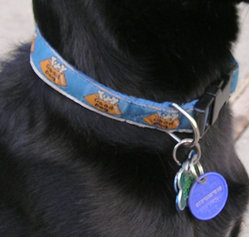 A Dog might wear several different identifying Dog tags.
A Dog might wear several different identifying Dog tags.|
From Wikipedia the free encyclopedia, by MultiMedia |
 A Dog might wear several different identifying Dog tags.
A Dog might wear several different identifying Dog tags.
A Dog tag is a small flat tag worn on collars or harnesses by Dogs, usually with identifying information such as the owner's telephone number so that the owner can be notified if the Dog is lost.
Dog tags were traditionally worn on a chain, rope, or collar around the Dog's neck. The resemblance of human identification tags to this method of display led to them also being called Dog tags; see Dog tag (identifier). Some Dogs wear harnesses instead of collars, so tags might be attached there instead. Most humane societies and rescue organizations recommend that Dog tags be on a buckle-type collar rather than on a slip collar, because the former remains more securely fastened around a Dog's neck when slipping through a fence or being held by a stranger.
Identifying information on a Dog tag might include:
Some organizations recommend not putting a Dog's name on a tag because, in an ownership dispute over a stray Dog, the original owner could use the Dog's name to demonstrate that the Dog recognizes the name and therefore has an association with that owner. Others believe that a lost Dog might feel more comfortable if strangers call it by its own name.
Tags are made of many different materials. Metal tags usually have the information embossed or etched onto the surface, and might also have electronic chips embedded. Plastic chips can be etched or printed, come in many colors, and are often highly reflective to make the Dog more visible if it gets loose and runs into the street after dark.
Dog tags on a collar are easiest to use for random people who find a Dog wandering loose.
Although Dog tags can help to return a stray or lost Dog to its owners, they are unreliable as a sole source of identification for several reasons. The owner might move or change phone numbers and forget to update the tags. Dogs often leave their collars behind when escaping from a yard, particularly when squeezing through or under a fence. Some owners don't want their Dogs wearing collars unsupervised, and unsupervised Dogs are more likely to be able to escape from a yard. Well-intentioned rescuers might remove the Dog's collar and tags to be able to read the phone number, and the Dog might disappear again. Collars and tags can also be removed intentionally by thieves, leaving the Dog unidentifiable.
Today, microchip implants, tattooing, and registering the Dog's license number, microship information, and tattoo number with lost-pet registries are strong backups to the collar Dog tag, but cannot be completely relied on, either, as people unfamiliar with such technology might not know to check for such identification or be able to figure out where to call. Another option is DNA fingerprinting although this is much more rare.
Dog tag is a small flat tag worn on collars or harnesses by Dogs, usually with identifying information such as the owner's telephone number so that the owner can be notified if the Dog is lost.